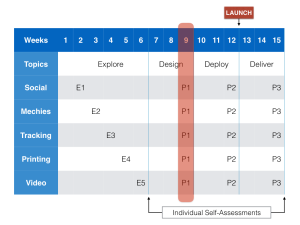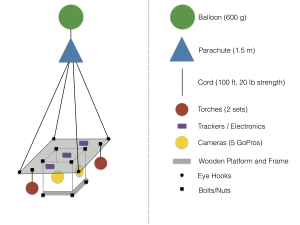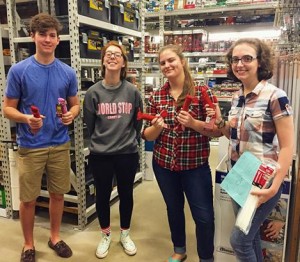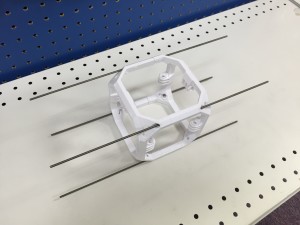 This week, the last week of our design phase, and the last week of class before Spring Break, opened with some very clear action items. We needed to finish our design plan, and purchase the remaining items necessary so that we could assemble and test our payload as soon as the students returned to campus.
This week, the last week of our design phase, and the last week of class before Spring Break, opened with some very clear action items. We needed to finish our design plan, and purchase the remaining items necessary so that we could assemble and test our payload as soon as the students returned to campus.
 Working together with the whole class, we finalized our sketch for the payload design (see image). We also decided to purchase the Flight Tracking Computer, APRS Radio Transmitter, and Helium Tank Inflator from High Altitude Science, especially given our concerns over the tracking devices we already had… We also began the process of searching for someone who had a Ham Radio license who would like to participate in the launch and help the students use the APRS Radio Transmitter.
Working together with the whole class, we finalized our sketch for the payload design (see image). We also decided to purchase the Flight Tracking Computer, APRS Radio Transmitter, and Helium Tank Inflator from High Altitude Science, especially given our concerns over the tracking devices we already had… We also began the process of searching for someone who had a Ham Radio license who would like to participate in the launch and help the students use the APRS Radio Transmitter.
 At that point, approximately a third of the class headed to Lowe’s to purchase the hardware needed to assemble the payload. The most difficult thing to find was a suitably sized threaded rod (3mm in diameter) to connect the two halves of the 3D-printed GoPro camera rig to each other and to the payload platform (we eventually found correctly-sized rods at Hobby Town USA).
At that point, approximately a third of the class headed to Lowe’s to purchase the hardware needed to assemble the payload. The most difficult thing to find was a suitably sized threaded rod (3mm in diameter) to connect the two halves of the 3D-printed GoPro camera rig to each other and to the payload platform (we eventually found correctly-sized rods at Hobby Town USA).
 In the meantime, while Team Printing continued to work on their design for the 3D-printed FSU Torches, and Team Video continued to tweak the design for the 3D-printed GoPro camera rig. We decided to purchase a specialized coating for the 3D printed devices to make them stronger and less likely to delaminate. We also tracked down at least two people on campus who already had access to the software we would need to stitch together our 360 degree videos, all of whom were delighted to work with the students to assemble the videos, once we got the cameras back from space. Team Tracking continued to work with the cellular and satellite trackers, figuring out how each worked in more detail.
In the meantime, while Team Printing continued to work on their design for the 3D-printed FSU Torches, and Team Video continued to tweak the design for the 3D-printed GoPro camera rig. We decided to purchase a specialized coating for the 3D printed devices to make them stronger and less likely to delaminate. We also tracked down at least two people on campus who already had access to the software we would need to stitch together our 360 degree videos, all of whom were delighted to work with the students to assemble the videos, once we got the cameras back from space. Team Tracking continued to work with the cellular and satellite trackers, figuring out how each worked in more detail.
The students then headed off for Spring Break with some very clear action items for each team…
- Team Video needed to finalize their design of the GoPro camera rig, print the two halves, coat them with the new protective coating, install the five cameras, and test! This may involve finding the correctly sized screws for attaching the camera cases to the mount, as the screws that come with the GoPro cameras didn’t quite have room to fit in the rig.
- Team Printing needed to finalize their design of the FSU Torches, and figure out how to attach them to the payload platform. Once determine, they need to print, decide whether or not to coat with the protective coating, install, and test.
- Team Tracking needed to finish testing the cellular and satellite tracking systems, and make a go / no go decision on each (additional testing during Spring Break demonstrated that the satellite tracking system seems to be working properly). They also needed to figure out how to use the new APRS radio transmitter.
- Team Mechies needed to finish gathering all the required materials to assemble the payload, built it, and test it under all possible conditions.
- Team Social needed to figure out a method for ramping up our social media campaign without knowing the actual date of launch for certain (we are still aiming for Saturday, April 2, at this point).
- We also needed someone to take point on figuring out the new Flight Tracking Computer, Pressure/Temperature Sensors, and APRS Radio Transmitter.
Finally, each team handed in a brief progress report (Progress Report 1) detailing their accomplishments over the last three weeks; these progress reports were posted to the students’ website.
P.S. Over Spring Break, word continued to spread about our plans to Launch the Torch, and several people reached out to us looking for ways to participate, including:
- Digitech, which asked the students to showcase their technologies at an annual event for student innovation on March 30, as part of FSU’s Research and Innovation Week.
- The local student chapter of ACM SIGGRAPH, which volunteered to work with our students to edit the 360 degree videos.
- The FSU Meteorology department, which volunteered to help track our weather balloon using a variety of technologies including Theodolites.
- The Tallahassee Amateur Radio Society, which volunteered to help our students track the balloon using our APRS Radio Transmitter.